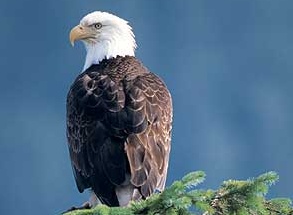Bald eagle adjectives: majestic, patriotic, awesome. And…Southern Californian.
Proving that yes indeed SoCal is a diversity hotspot for critters, our national symbol is both a part-time and full-time resident in our mountains and wind-swept open areas. Since the 1990s many migratory baldies make winter pilgrimages to several lakes in Southern California and today, some white-headed flappers have made SoCal their permanent homes.
Across the ocean channel, bald eagles have also made a comeback on the Channel Islands with fans glued to cameras recording nesting activities on Santa Cruz and Santa Catalina Island. From 2002 to 2006, 61 bald eagle juveniles were released on Santa Cruz Island and they have spread out to nest on Santa Cruz, Santa Rose, Anacapa and Catalina Islands. These eagles are closely watched by biologists.
But off island, federal and state biologists hold an annual Bald Eagle Count at local lakes from December through March to monitor the flappers in a low-tech way: with binoculars and volunteers.
“This was a good year for our count,” says Robin Eliason, district biologist with the San Bernardino National Forest Service about the birding event that teams up federal and state biologists with an eager public. A total of nine eagles (7 adults and 2 juveniles) were counted by teams at Big Bear Lake, Lake Arrowhead, Silverwood Lake, Lake Hemet, Lake Gregory and Lake Perris. (It takes young eagles 4-5 years to reach their full white head and tail markings, making them a little difficult to spot for beginning birders who often mistake them for say, turkey vultures.)
It’s just a one hour count, Eliason explains, but that snapshot can tell biologists a lot about the health and stability of the bird that didn’t fare well in SoCal for many years. (Want to help count next year? Click here to keep informed.)
In the late 70s, you couldn’t find a baldie anywhere in Southern California; they were only seen in Northern California. The Bald Eagle Count was a national effort, says Eliason because at that time, eagles were suffering the effects of DDT, a chemical that caused female eagles to lay eggs with abnormally thin shells which couldn’t sustain a chick. In the lower 48 states, eagle numbers reached a dismal low with only 500 nesting pairs. Today more than 10,000 nesting pairs (outside of Alaska) are reported in the United States.
When the bald eagle was finally removed from the Endangered Species List in 2007 (it was on the list for nearly three decades), many national locations stopped the count. But not the one here in Southern California; in the late ’90s the white-headed bird was finally making inroads in the area and officials thought it best to keep monitoring them.
When the first baldies came back to Southern California, biologists trapped and banded them to see where they went. Those eagles have traveled as far as Snake River, Idaho, Yellowstone National Park and even the Great Slave Lake in Alberta, Canada. (What? No postcard?)
Today, no such elaborate study is being done, except for the annual count.
Eliason remembers the day where the first known pair of eagles stayed back from its northerly migration to nest and … raise little ones. “That was two years ago and we were all ecstatic,” she says. Taking an educated guess, Eliason thinks there are about three nesting pairs in Big Bear. Lucy and Ricky can be seen around the Fawnskin while George and Gracie – so named because of their noisy bickering – have been spotted near Eagle Point
“We are so lucky to be able to see them year-round,” she says. “To have them in our own backyard is amazing. I have seen people tear up when they see them; they bring out the best of our emotions.”
— Brenda Rees, editor


